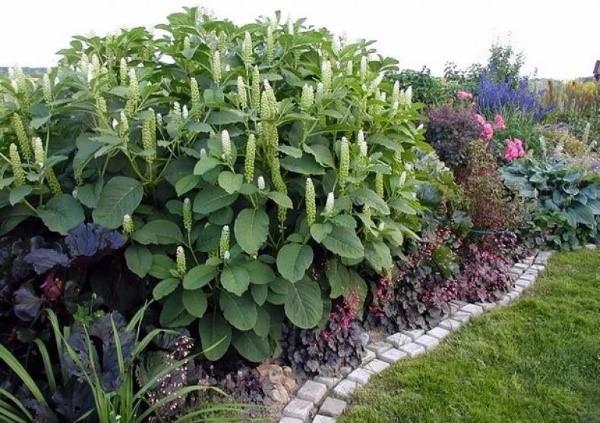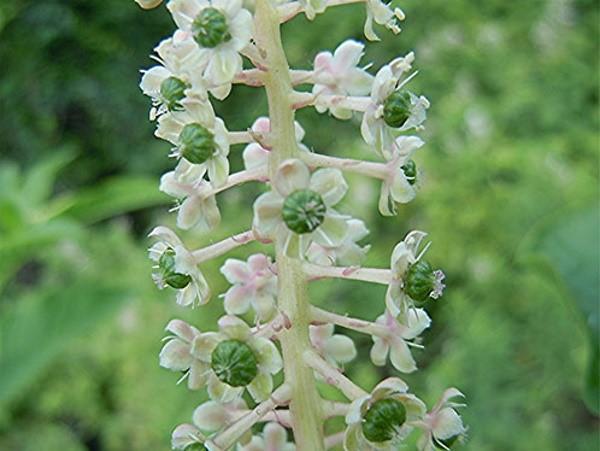Lakonos: planting and caring for a giant bush with original flowering
 Do you admire the candles of chestnut blossoms, but do not have so much free space on the site for this tree? Then grow lakonos, planting and caring for which does not require excessive effort. Of course, this is far from a mighty chestnut, but just a tall herbaceous bush. But its flowering is really very similar to chestnut candles, and the fruits are no less original.
Do you admire the candles of chestnut blossoms, but do not have so much free space on the site for this tree? Then grow lakonos, planting and caring for which does not require excessive effort. Of course, this is far from a mighty chestnut, but just a tall herbaceous bush. But its flowering is really very similar to chestnut candles, and the fruits are no less original.
Lakonos is a perennial with a pronounced dormant period, moreover, it is completely unpretentious. Before the flowers bloom, the plant is nothing special. Just think, just a tall weed. But when flowering begins, the bush immediately attracts attention, however, as in the period of fruit ripening. Today we will talk about what a plant looks like and how to grow it in a garden.
Among gardeners, Lakonos is also known as oily grass, kermes berry and Jewish ivy. In the scientific literature, it is called phytolacca.
Botanical characteristics of culture

If you rip off a leaf and rub it with your fingers, the scent will not be pleasant. Better to admire the lakonos from afar.
 In the middle of summer, long, cob-shaped peduncles with small white flowers begin to form. They are similar to chestnut candles, but only thin, up to 25 cm long. Flowering continues until the end of summer, and then the fruits ripen.
In the middle of summer, long, cob-shaped peduncles with small white flowers begin to form. They are similar to chestnut candles, but only thin, up to 25 cm long. Flowering continues until the end of summer, and then the fruits ripen.  These are small, round and slightly flattened berries. Each consists of 10 lobules with seeds. At first, the berries are light pink, and at the stage of full ripeness they become dark purple, almost black. Red tassels with black fruits look very impressive, and they hang on the branches until the first frost.
These are small, round and slightly flattened berries. Each consists of 10 lobules with seeds. At first, the berries are light pink, and at the stage of full ripeness they become dark purple, almost black. Red tassels with black fruits look very impressive, and they hang on the branches until the first frost.
Lakonos is a unique plant, both useful and a little dangerous. Perennial inflorescences are good honey plant for bees, but its fruits cannot be eaten due to their toxicity. But the roots of some species of lakonos are often used in folk medicine as a wound healing and bactericidal agent.
The lakonos bush is a perennial, but in winter its aerial part dies off. Only the rhizome hibernates - a thick rod that goes deep into the soil, where it is not afraid of frosts. In the spring, the plant recovers, releasing young growth, including lateral growth, growing on the site.
Popular varieties for garden cultivation
More than 2 dozen species of this plant grow in natural conditions.
In gardening, however, three laconos are most often found:
- American. A tall rounded bush up to 3 m in height, leaves are light green, up to 40 cm long. Inflorescences are erect, with a slight salad shade, flowering lasts from June to September. Fruits are purple-black, ripen in early autumn. Both roots and stems have medicinal properties, although they are poisonous, so they should be used carefully.Reproduction of the American lakonos occurs by seed and vegetative means, like other varieties.

- Grape or berry. Differs in dark and more pointed leaves and fruits, more like blackberries. Inflorescences are pink, lush. In addition, the root of this plant is poisonous, like the berries, but young shoots and leaves in Asia are eaten.

- Multicameral or club-shaped. The species is characterized by a pink color of inflorescences, smaller leaves and shoots up to 1 m long.

Lakonos: planting and caring for a perennial in the garden
 Considering the large size of the perennial, choose a well-lit place in the garden for the lakonos. By the way, in partial shade the bush will also feel good, but it will not catch up with its comrades growing in the sun in size. But with good lighting, the plant will be taller, and fruiting will come earlier and will be more abundant. But what should be taken care of in advance is the absence of drafts. Peace and comfort are especially important for young plants until they get stronger. But even for adult Lakonos, the wind is useless, since it can break the shoots.
Considering the large size of the perennial, choose a well-lit place in the garden for the lakonos. By the way, in partial shade the bush will also feel good, but it will not catch up with its comrades growing in the sun in size. But with good lighting, the plant will be taller, and fruiting will come earlier and will be more abundant. But what should be taken care of in advance is the absence of drafts. Peace and comfort are especially important for young plants until they get stronger. But even for adult Lakonos, the wind is useless, since it can break the shoots.
Regarding the soil, then for growing a flower of a lakonos, it must be fertile, preferably black soil with a low acidity... However, loams and sandy-peat soil will also work for him. On poor soil, the bushes will be lower, and the foliage will grind.
How to plant lakonos
 The perennial is grown mainly by seed method.
The perennial is grown mainly by seed method.
You can sow seeds directly into open ground:
- before winter, covering crops with leaves;
- in the spring, when the frosts pass.
If desired, you can sow lakonos in early spring for seedlings.
Sow the seeds dry in autumn, and for spring planting it is better to stratify for at least 3 weeks. Then, a day before planting, soak the seeds in water or with the addition of a growth stimulator. This will increase the germination rate of phytolacca and make it possible to get more seedlings.
 Transplant seedlings to a permanent place no earlier than May, while using the transshipment of plants. Lakonos does not like to be disturbed by the roots. Take this into account when growing seedlings, immediately sowing seeds in separate containers so that you do not dive later. It would be best to use peat or paper cups altogether and plant them in the ground with them.
Transplant seedlings to a permanent place no earlier than May, while using the transshipment of plants. Lakonos does not like to be disturbed by the roots. Take this into account when growing seedlings, immediately sowing seeds in separate containers so that you do not dive later. It would be best to use peat or paper cups altogether and plant them in the ground with them.
With regard to the cultural neighborhood, phytolacca is an aggressive plant. It requires a lot of space due to its size, and it grows quickly. Do not plant other crops next to it closer than 2 m from the perennial, otherwise it will drown them out. But there is also a positive point: Lakonos scares away many pests... If you plant bushes around the perimeter of the garden, protect your beds, plus decorate the site.
Caring for lakonos in the garden
 Oily grass is generally unpretentious and will require your attention only in the first few years. While the plants are young and immature, they need help. In the future, the bush will be able to grow practically without your participation.
Oily grass is generally unpretentious and will require your attention only in the first few years. While the plants are young and immature, they need help. In the future, the bush will be able to grow practically without your participation.
Caring for a lakonos is simple and consists of the following activities:
- Timely watering. The culture does not tolerate drought, but it will not grow in a swamp either. As soon as the ground under the bush dries up, spill it abundantly.
- Top dressing. Adult specimens with a well-developed rhizome can grow without additional fertilization. Deep in the soil, the roots are able to get food. But in the first two years, the seedling needs to be helped to grow stronger. Feed it twice a month with mullein infusion from spring to fall.
- Pruning. It is not necessary to form a lakonos, he copes with this remarkably well himself. But be sure to cut off the aerial part in the fall - it will die out anyway.
- Preparing for the winter. In the southern regions, the perennial hibernates without shelter, because its roots are deep underground. But if you have a young plant or severe winters with little snow, it is better to mulch the trimmed remains of the stems with a thick layer of peat or foliage.
For tall varieties of lakonos, it is better to install a support.
Phytolacca propagates by seeds or by dividing the bush. Collect seeds in September-October and sow immediately in the garden. In the spring they will give amicable shoots. But start dividing the bush in the spring, while it is better not to touch the plants older than 5 years. You simply cannot completely dig them up without damaging the powerful taproot, and it will be difficult to separate it.
Thus, planting a lakonos and caring for it will not take much time and will not provide much trouble. An unpretentious perennial is almost independent and will surprise your guests with its bizarre fruits for many years. Not everyone has a similar plant, but let it grow for you for sure!